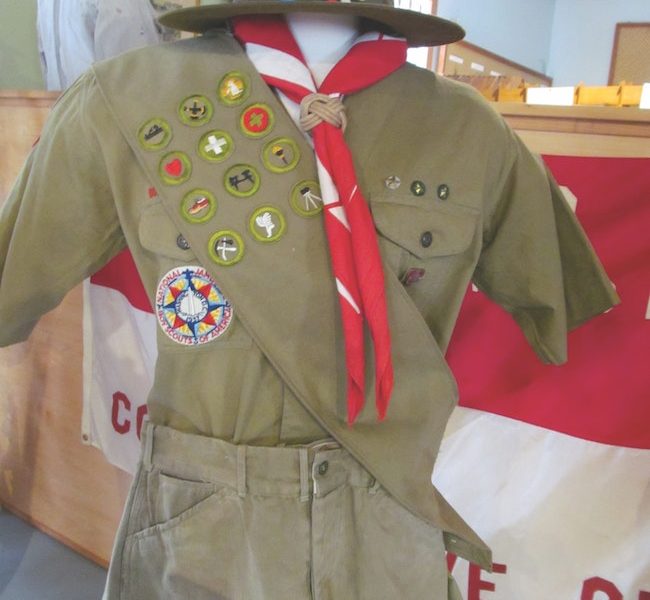 PHOTO PROVIDED – Robert “Mac” Trask’s 1937 Jamboree uniform.
PHOTO PROVIDED – Robert “Mac” Trask’s 1937 Jamboree uniform.
February is Scout History Month because the original incorporation happened on Feb. 8, 1910. While primarily known as a character-building organization, its origins are from the military use of scouting or reconnaissance about the terrain, strengths and movements of the enemy, all without being detected or caught. These skills are collectively called woodcraft or scoutcraft and include tracking, stalking, foraging, making smokeless fires, and leaving no sign to give oneself away.
The man credited most for the formation of the youth program named scouting was British Military Officer Robert Baden-Powell (in later years known affectionately as “BP” by legions of scouts). As a student, BP had many talents, including playing violin, piano, acting, and was a talented, ambidextrous artist. In summer he went on sailing and canoeing expeditions with his brothers.
When his school, Charterhouse, moved out of London into the Surrey countryside, BP started to develop his woodcraft skills by hiding in the woods, and trapping and cooking rabbits; all activities strictly forbidden by the headmasters.
When he later joined the Army his skills were recognized by his superiors and he was assigned to military reconnaissance, often working disguised as a butterfly collector, drawing fort plans into his sketches of butterfly wings while stationed in Malta.
While in Africa he met and learned from American Army Scout Frederick Russell Burnham. In addition to all the scoutcraft Burnham imparted to Baden-Powell, his peaked Montana Stetson (Smokey Bear hat), and the many uses of the neckerchief were two influences that came from the American that became staples of the scouting youth program worldwide.
During a 217-day siege by the Boer Army, BP used his many skills to deceive and hold at bay the much larger forces encircling the village of Mafeking. The publicity of the siege made BP a household word in England and a hero of sorts when he and his men were finally relieved. During the siege young cadets did many jobs such as carrying messages, assisting in first aid, and lookouts. While the youth service was not BP’s idea he did observe how effective the boys were.
The Army leadership did not take a kindly view of his actions and he was posted home. BP was surprised to find, on his arrival in England in 1903, that his book “Aids to Scouting” – which he had written as a guide for military scouts – was popular with teachers and boys and got him thinking of his experiences with the cadets at Mafeking.
Another influence on BP was meeting Ernest Thompson Seton in 1906. Seton had his own youth organization, the “Woodcraft Indians,” and gave BP a copy of his book, “The Birch Craft Roll,” outlining that program. Baden-Powell took all these ideas and 22 boys from both upper- and working-class families camping on Brownsea Island to test out his evolving thoughts of a youth program.
The resulting and rewritten scout hand book, “Scouting for Boys,” was published in 1908 (in six installments) and has sold over 150 million copies, making it the fourth-most popular book in the 20th Century.
The scouting program spread like fire in England and a scout doing his daily “good turn” had the result of bringing the program to America.
W.D. Boyce, an American publisher, was in London on business and was having difficulty finding his destination, when a young scout approached him and offered to take him there. On arriving at the address he reached into his pocket to offer a tip, which the scout refused, explaining that each scout was supposed to do a good deed each day as part of their promise. Intrigued, Boyce asked the scout more and learned about the scout headquarters and before leaving London picked up publications and information on the program.
Boyce along with several others incorporated the Boy Scouts of America (BSA) on Feb. 8, 1910. The real early organizer was Edgar M. Robinson, who was a senior administrator of the YMCA in New York City. Robinson put together meetings with other youth program leaders, particularly Daniel Carter Beard (Sons of Daniel Boone), Seton (Woodcraft Indians), and several other budding scout programs. They all agreed to fold their programs into the BSA, with Seton serving as Chief Scout and the others serving as commissioners. Seton also wrote the first version of the BSA scout handbook.
While most of the scout-like programs joined together into the BSA, a notable exception was William Randolph Hearst’s American Boy Scout program. This rival program lasted until 1918, then after a few twists and turns, it sputtered out.
By the fall of 1910 there were over 2,500 leader applications and nearly 160,000 youth inquiries from 44 states. After setting up the national office in NYC Robinson wished to return to the YMCA full time and James E. West, a lawyer who advocated for children’s rights, was hired as the first Chief Scout Executive, a position he held for 32 years.
When the scouting program first hit Cottage Grove is hard to say with certainty. On making an inquiry at the local Oregon Trail Council office, it was learned that many of the early records were lost in a fire in the 1970s and the National Council doesn’t keep those sorts of records in any accessible form. Using the UO’s historic Oregon Newspaper search site the first mention made of scouting locally was a story in the Dec. 9, 1913 Cottage Grove Leader, “The organization of a troop of the Boy Scouts of America was effected Friday afternoon at the Baptist Church starting with three full patrols and a fourth well on the way.” It was reported that the acting Scout Master was Rev. Cobb and that, “The boys are enthusiastic to learn the first stages of scout craft and qualify as a ‘tenderfoot’. They are learning the scout oath, sign, salute, and law.”
Several other mentions were found in the teens and early ’20s, including a report that scouts helped to sell over 300 million dollars in war bonds during WWI nationally. In March of 1923 there was an invitation for all boys interested in forming a scout troop to a “bean feed” at the CG Armory as guests of the American Legion. “Each boy is expected to bring a plate, cup, and spoon.” This event was following an initial meeting at which seven boys were present. By April that troop had over 30 boys “organized under the direction of Calvin Funk Post of the American Legion.” A short piece in the local paper announced that the scouts would be meeting at the armory, then hike up to Mt. David for a weiner roast at which no matches would be allowed. The scouts would “be required to build a fire using methods they have learned in scout class and that each boy will be expected to know a story or joke to repeat while sitting around the campfire.”
Now nearly 100 years later those same activities are staples of scout campouts and the Calvin Funk Post is still sponsoring both a scout troop and cub pack.
In 1935 it was planned to celebrate the 25th anniversary of the BSA with the first National Jamboree to be held in Washington D.C. It was planned to have tens of thousands of scouts from all over the country camping and demonstrating their scout skills on the National Mall. Even as some scouts were aboard trains heading to the Jamboree, President Franklin Roosevelt issued a proclamation canceling the event due to an outbreak of polio. Sound familiar? Pandemics are no new thing.
Two years later in 1937 the threat had diminished enough for the planned event to go forward and over 25,000 scouts descended on the Nation’s Capital. It was a pretty select crowd as only one scout from each troop was allowed to go. A troop was formed representing what was then known as Willamette Council BSA and a real adventure was planned with a train trip that took a northern route with stops in Salt Lake City, Chicago, Detroit, Niagara Falls, New York City, and Philadelphia before arriving at the Jamboree. On the way back the scouts took the southern route and saw Atlanta, New Orleans, and stops in Texas and San Francisco before returning home to Eugene.
At least five Cottage Grove scouts went on this adventure. Carlton Woodard, Vinal Randall Jr. and Robert McGee “Mac” Trask were were known to have attended.
Trask, son of Dove Trask, a local historian, was killed in WWII but his mother kept all of his mementoes that he got along his big trip or swapped for at the Jamboree. His uniform with the Jamboree patch and special neckerchief were saved as well. A chance snippet of conversation led to this collection being donated to the Cottage Grove museum.
This bygone era when life was simpler and more united by a common goal will be on display at the CG Museum through May and along with the Jamboree items there are early photos, newspaper articles, patches, uniforms, books, flags and a WWI 3rd Liberty Loan poster featuring a kneeling scout offering a sword emblazoned with the scout motto “Be Prepared” to Lady Liberty.
There have been many changes. The Cub Scouts were added in 1930, Sea Scouts and Air Scouts were introduced along with programs for older youth, such as Senior Scouts, Explorers, and Venturing.
Locally there is still an active Cub Pack and Scout Troop. One change is that now Scout and Cub units can choose to have girls join as scouts. The local unit for girls is Troop 4140 and along with Troop 140 shares leadership, parents, and siblings in its membership. The kind sponsorship of the local American Legion Post allows scouting to continue in Cottage Grove.
The Scouting History display is viewable Saturdays and Sundays 1-4 p.m. at the Cottage Grove Museum at H & Birch Streets. If any readers know youth interested in either Cubs or Scouts please use the email below to contact the scout leaders.
Happy 112th birthday Scouting, preparing today’s youth for tomorrow’s leaders.
Email: [email protected]








